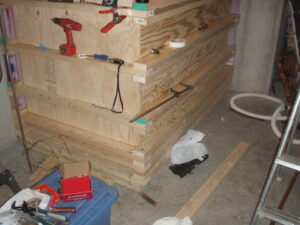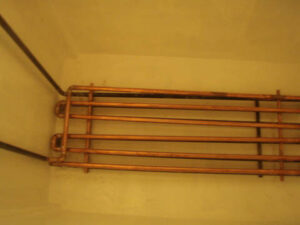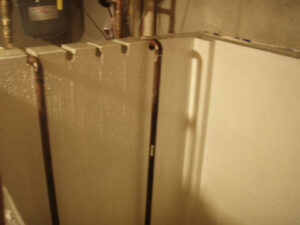Many today are looking for alternative heating methods that are environmentally friendly, or “off the grid.” One option is using a Water based heating system heated by solar power, wood, or oil burning. We found this post which initially appeared on a customers blog it has some great plywood tank plans for building with Sani-Tred.
Building a Thermal Plywood Tank With Sani-Tred
The storage tank is an optional but very helpful component in the system. Without the ability to store heat, a wood boiler needs to “idle” the fire whenever there is no house demand. Although they can do this, it is inefficient and builds creosote. This also wastes solar input (when available). Storage changes this equation by allowing solar to be stored whether DHW is required or not, and by allowing a wood fire to be run at full output, eliminating creosote buildup and allowing fewer, larger fires to be built.
Storage Tank Design
BuildItSolar has links to projects built by others that you can use as inspiration. I followed a similar route to Gary Reif, although due to space and cost considerations I went with a shorter, wider profile (48″W x 88″L x 48″H inner dimensions). Allowing 3″ of air space for solar drain-back, and knowing that a cubic foot of water is 7.48 gallons, this tank can hold over 820 gallons of water.
What does this do for you? The next factor to consider is “usable range,” which is the difference between the highest temperature water you plan to store in the tank and the lowest temperature at which that water is still doing useful work. I wanted to get the most out of my system so I went for a large usage range of 140F to 200F, or a total of 60F of range.
It takes 8.34 BTU to raise one gallon of water one degree F. 820 gallons * 60F * 8.34 BTU/gallon/F yields 410kBTU of heat storage. My wood furnace can produce 110kBTU/hr of heat, so if there was no house demand it could “charge” the tank in about 4 hours, and then the tank might be good for anywhere from 12 hours to 5 days, depending on house heat requirements.

Storage Tank Construction
As depicted above, the tank design is simple. Sheets of plywood form the sides, and the tank is sized to make the best use of exact sheets (you want to minimize joint lines). 2×4 studs providing clamping force to prevent the walls from flexing. I used five sheets of furniture-grade 23/32″ plywood (a high-quality material with no voids, and it’s only a few dollars more than other grades) and about 30 studs.
At the corners I used Simpson Strong-Tie plates and their special screws to create absolutely rigid joints between the studs, and I used coated deck screws to attach the plywood to the studs and in other misc. areas (these screws can take more water exposure than most others). (Yes, I have screw holes inside the tank – read on.) One sheet of plywood (not shown) plus a pair of strap hinges forms the lid, which rests on a “lip” of Trex decking board material. Total rough construction cost was about $350.
Insulation is critical for a tank like this. Some builders using EPDM liners use foam board inside the tank, which eliminates “thermal bridging” (heat transfer through the wood structure itself), but foam wasn’t a suitable substrate for the Sanitred tank sealant. I chose to use polyisocyanurate sheets (“Iso Board”) on the outside of the tank instead.
This can get expensive if you buy it from a retail supplier. I found mine surplus on Craigslist and was happy I did because the supplier I found had 4″ thick sheets. My particular product is supposed to have an R value of 8 per inch, so one layer gives me R-32. I used one layer underneath and on top of the tank, and two layers around the two sides in contact with the concrete walls of my basement. The more insulation you have the longer you can hold heat in your tank (although for heating purposes, a small amount of loss into the basement is no great sin).
The iso-board sheets are tricky to cut when they’re thick. I had the best luck with a Sawzall and a long blade. Hack saw and drywall blades also work by hand. Utility knives get stuck – they’re hard to use on thicknesses greater than 2″. Where I had small gaps or imperfections, I sealed those with Great Stuff. The DIY plywood tank is going to be impossible to move once it’s full of water. Take your time and do a good job.
Sealing
EPDM liners are a popular choice, and they’ve held up well for most builders. But I’ve always been nervous about them because their temperature rating is technically only up to 180F. Although some have used higher tank temperatures than that, I didn’t want to lay awake at night worrying about the liner of an 850-gallon water tank deteriorating.
The alternative I went with is a product from Sanitred called PermaFlex. This is a brush/roll-on sealing system that can be used to seal basements, pools, ponds… and tanks. It’s actually a 2-component system: a liquid-rubber gap filler is used to bridge gaps, holes, cracks, and seams with a flexible membrane, a sealant that provides the actual waterproofing. The system is rated to 250F and is guaranteed to be water-tight.
I’m fairly happy with this product – it was reasonably priced and easy to apply. But I did run into a few gotchas – if you follow in my footsteps, bear these in mind:
- Tool cleanup is with acetone or MEK. No biggie, but disposable roller covers and brushes make working with it a lot easier.
- Use a mixing paddle for a drill. The instructions say this is a nice-to-have – I would call it essential. The product must be mixed well to work properly, and it’s very thick so it’s very hard to mix by hand. Don’t bother to clean the paddle. After it cures, it will peel right off the paddle (assuming it’s made of plastic).
- Point a fan at your work area. This stuff has very low odor, which sounds great – but it’s only low odor. The fumes can sneak up on you, so ventilation is important.
Important Note: You have to make the applications back-to-back, within 4 hours of each other. This allows each layer to chemically bond to the previous one. According to Sanitred, if you wait a day or more between applications you have to chemically prep the previous surface with something aggressive, like Xylene. Set aside an entire day for the project, and make sure you have all of the product you need ahead of time.
I used 2 gallons of Permaflex and 1 gallon of Liquid Rubber Base (LRB) plus a gallon of Thickening Activator (TAV) since I had plenty left over. If I was doing it all over again, I would have bought 2 gallons of Permaflex, 2 gallons of LRB, 1 quart of TAV, plus a fillable caulk tube, and done the following:
- Prime with 1 gallon of Permaflex. Wait 20 minutes, then apply another coat to all cut plywood edges (it soaks in). Don’t forget to do the lid, too.
- Mix 2 quarts of LRB with 1 quart of TAV (a 2:1 mixture is recommended). Sanitred recommends a baggie for the next step, but if you get a cheap fillable caulk tube it’s MUCH easier. This stuff is very thick! Lay down a thick bead in every tank corner/seam, plus a healthy dab on each screw hole. Use a putty knife or similar to smooth it out. Don’t over-work the material – it stiffens quickly and it’s hard to “work”. It doesn’t have to be pretty – nobody will ever see it. If you care, Sanitred says you can lightly smooth the surface with a Xylene-soaked brush. I didn’t bother.
- Catalyze the rest of the LRB and pour it into the tank. I had less than a gallon of LRB left by now and didn’t get complete coverage – if you have over a gallon, you should end up with a membrane over the entire bottom of the tank. This coat is much thinner, so it self-levels.
- Once the LRB sets up apply the final coat of Permaflex. This is tricky because the LRB is still soft so you can’t get into the tank any more to work on it. A paint roller on a pole is best here. Pay particular attention to areas where there were holes or cut edges. I double-coated all of those.



